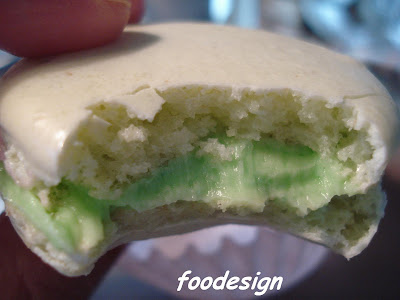The purpose of this post is to document my two-day macaron experiment. I have read much about these delicate French cookies and it seems like there's an ongoing quest out there just to be able to successfully make them. Based on the discussions I've read, they're very tricky to make and difficult to master. I guess that was what initially caught my attention and made me want to try to make them myself. For starters, the first time I had them was not too long ago, at Bizu Patisserie, when we were in Manila. I just had to at least know how they taste like before I try to make them.

Shown above: (1) The piped mixture still produced the so called "feet" despite the thin and overmixed meringue batter. (2) Irregularity in shapes was caused by overmixing resulting in a runny batter that spread out too much. (3) It wasn't easy to peel off the baked cookies from the parchment paper and they were also very sticky and gummy. (4) Sandwiched together with buttercream, they looked alright and were tasty, but some have toasted shells while some were very fragile and chewy.
My first attempt (shown above) was using the French technique of making the meringue, beating the egg whites with granulated sugar until stiff and then gradually folding in the nut flour/powdered sugar mixture. I didn't really know what consistency to watch out for so this was totally trial and error. I had over beaten the mixture, resulting in a very thin and runny batter. The piped mixture spread out fast and lost its shape but the cookies still managed to develop "feet" and rose high while baking. They came out very sticky, clinging to the parchment and peeling them off the paper wasn't easy. I also tried to increase the heat for the second batch to try to dry them off but the intense heat toasted them instead resulting in a hard shell and chewy interior but still edible.
 For my second attempt (shown above), I tried the Italian meringue method which required cooking the sugar with some water to a soft ball syrup stage, then slowly pouring it into beaten eggwhites while mixing continuously, same as making boiled icing. It is crucial to use an electric mixer as well as a candy thermometer for this method. I like this a lot better. The meringue was more stable this way and I was able to incorporate the nut flour/powdered sugar mix at a much slower pace. I was also able to tint the meringue in three pastel shades. The trick was finding the correct consistency of the batter and when to stop folding, before piping it out. I had to do additional folding for the first batch I did because the batter was not spreading at all which indicated that it was still under mixed. I had to take it out of the piping bag and stir again. Messy, but it was a good decision. After I got it right, the mixture spread out just right and I had a feeling then that I may be on the right track.
For my second attempt (shown above), I tried the Italian meringue method which required cooking the sugar with some water to a soft ball syrup stage, then slowly pouring it into beaten eggwhites while mixing continuously, same as making boiled icing. It is crucial to use an electric mixer as well as a candy thermometer for this method. I like this a lot better. The meringue was more stable this way and I was able to incorporate the nut flour/powdered sugar mix at a much slower pace. I was also able to tint the meringue in three pastel shades. The trick was finding the correct consistency of the batter and when to stop folding, before piping it out. I had to do additional folding for the first batch I did because the batter was not spreading at all which indicated that it was still under mixed. I had to take it out of the piping bag and stir again. Messy, but it was a good decision. After I got it right, the mixture spread out just right and I had a feeling then that I may be on the right track.



 Reading and comparing the different techniques, measurements, timing and combinations, proved very helpful. There were many pictures of the finished pastries online that I used as guides. I also have to make some of the chocolate and coffee macaron versions sometime. I guess it helped a little that I'm used to baking chiffon cakes and making boiled icing using the same basic technique with the sugar syrup. For the fillings, I just used a simple buttercream flavored with pistachio, raspberry and coffee but I'm sure there are many more interesting fillings and flavor combinations which I need to research and learn more about next. In the meantime, I think I need my macaron break!
Reading and comparing the different techniques, measurements, timing and combinations, proved very helpful. There were many pictures of the finished pastries online that I used as guides. I also have to make some of the chocolate and coffee macaron versions sometime. I guess it helped a little that I'm used to baking chiffon cakes and making boiled icing using the same basic technique with the sugar syrup. For the fillings, I just used a simple buttercream flavored with pistachio, raspberry and coffee but I'm sure there are many more interesting fillings and flavor combinations which I need to research and learn more about next. In the meantime, I think I need my macaron break!









No comments:
Post a Comment